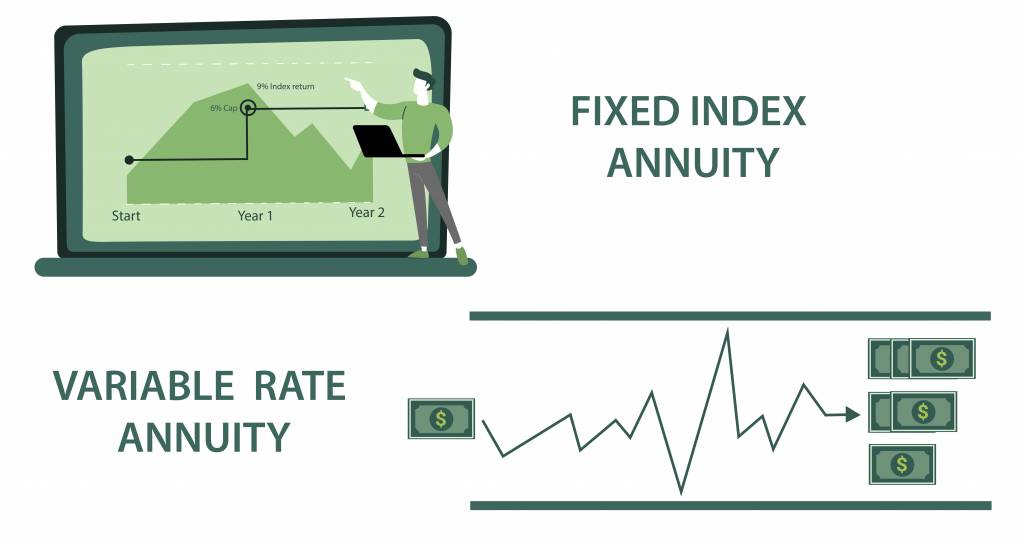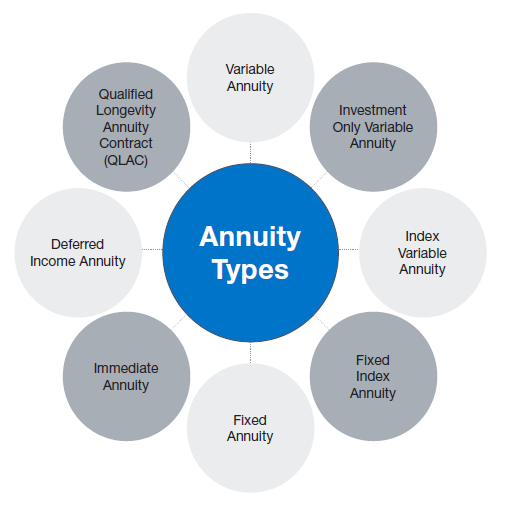All Categories
Featured
Table of Contents
The repayment may be spent for growth for a long period of timea solitary costs deferred annuityor spent momentarily, after which payout beginsa solitary costs prompt annuity. Single premium annuities are usually moneyed by rollovers or from the sale of a valued asset. A flexible costs annuity is an annuity that is planned to be funded by a series of payments.
Proprietors of repaired annuities know at the time of their purchase what the worth of the future cash money circulations will certainly be that are created by the annuity. Obviously, the variety of capital can not be understood ahead of time (as this relies on the contract proprietor's lifespan), but the ensured, fixed rate of interest a minimum of offers the proprietor some degree of assurance of future income from the annuity.
While this distinction appears straightforward and uncomplicated, it can dramatically affect the value that a contract proprietor inevitably originates from his or her annuity, and it produces significant uncertainty for the contract proprietor - Indexed annuity benefits. It additionally usually has a material effect on the level of charges that an agreement proprietor pays to the issuing insurance business
Set annuities are often used by older capitalists that have actually limited possessions yet who intend to offset the danger of outlasting their properties. Set annuities can act as an effective tool for this objective, though not without certain drawbacks. For instance, when it comes to instant annuities, once an agreement has actually been purchased, the contract proprietor gives up any kind of and all control over the annuity properties.
Analyzing Strategic Retirement Planning A Comprehensive Guide to Pros And Cons Of Fixed Annuity And Variable Annuity What Is Fixed Income Annuity Vs Variable Growth Annuity? Advantages and Disadvantages of Choosing Between Fixed Annuity And Variable Annuity Why Choosing the Right Financial Strategy Can Impact Your Future How to Compare Different Investment Plans: A Complete Overview Key Differences Between Variable Vs Fixed Annuity Understanding the Key Features of Long-Term Investments Who Should Consider Fixed Index Annuity Vs Variable Annuities? Tips for Choosing the Best Investment Strategy FAQs About Planning Your Financial Future Common Mistakes to Avoid When Choosing Fixed Index Annuity Vs Variable Annuities Financial Planning Simplified: Understanding Your Options A Beginner’s Guide to Smart Investment Decisions A Closer Look at Fixed Vs Variable Annuity Pros Cons
An agreement with a typical 10-year surrender period would certainly charge a 10% surrender charge if the contract was given up in the first year, a 9% surrender charge in the 2nd year, and so on until the abandonment charge reaches 0% in the contract's 11th year. Some delayed annuity contracts consist of language that permits tiny withdrawals to be made at numerous periods during the abandonment duration without fine, though these allowances normally come at a price in the form of reduced surefire rate of interest.
Equally as with a repaired annuity, the proprietor of a variable annuity pays an insurer a round figure or series of payments in exchange for the guarantee of a series of future repayments in return. Yet as stated over, while a taken care of annuity expands at an assured, consistent rate, a variable annuity expands at a variable rate that depends upon the performance of the underlying financial investments, called sub-accounts.
During the buildup stage, properties purchased variable annuity sub-accounts grow on a tax-deferred basis and are exhausted just when the agreement proprietor takes out those incomes from the account. After the accumulation stage comes the income stage. In time, variable annuity possessions need to theoretically enhance in value up until the agreement owner chooses she or he wish to begin withdrawing money from the account.
The most substantial problem that variable annuities usually existing is high expense. Variable annuities have a number of layers of charges and costs that can, in aggregate, develop a drag of up to 3-4% of the contract's value each year.
M&E expenditure costs are determined as a percentage of the agreement value Annuity companies pass on recordkeeping and other management prices to the contract proprietor. This can be in the kind of a level yearly cost or a portion of the agreement value. Management fees might be included as part of the M&E risk cost or may be analyzed separately.
These fees can vary from 0.1% for easy funds to 1.5% or more for proactively handled funds. Annuity agreements can be customized in a number of methods to offer the specific demands of the contract owner. Some usual variable annuity motorcyclists include ensured minimum build-up benefit (GMAB), ensured minimum withdrawal benefit (GMWB), and guaranteed minimum earnings benefit (GMIB).
Understanding Retirement Income Fixed Vs Variable Annuity Everything You Need to Know About Financial Strategies What Is the Best Retirement Option? Benefits of Choosing the Right Financial Plan Why Choosing the Right Financial Strategy Matters for Retirement Planning Variable Annuities Vs Fixed Annuities: A Complete Overview Key Differences Between Tax Benefits Of Fixed Vs Variable Annuities Understanding the Key Features of Variable Annuity Vs Fixed Annuity Who Should Consider Strategic Financial Planning? Tips for Choosing Variable Annuity Vs Fixed Indexed Annuity FAQs About Deferred Annuity Vs Variable Annuity Common Mistakes to Avoid When Planning Your Retirement Financial Planning Simplified: Understanding Retirement Income Fixed Vs Variable Annuity A Beginner’s Guide to Fixed Vs Variable Annuity Pros Cons A Closer Look at How to Build a Retirement Plan
Variable annuity contributions provide no such tax obligation deduction. Variable annuities have a tendency to be extremely ineffective automobiles for passing wide range to the future generation since they do not enjoy a cost-basis adjustment when the original agreement proprietor dies. When the owner of a taxed financial investment account dies, the cost bases of the investments kept in the account are readjusted to show the market costs of those financial investments at the time of the proprietor's fatality.
Such is not the instance with variable annuities. Investments held within a variable annuity do not obtain a cost-basis change when the original owner of the annuity passes away.

One substantial problem connected to variable annuities is the capacity for disputes of passion that may exist on the part of annuity salespeople. Unlike a financial consultant, who has a fiduciary task to make investment choices that benefit the client, an insurance coverage broker has no such fiduciary obligation. Annuity sales are extremely lucrative for the insurance coverage experts who market them due to high ahead of time sales payments.
Numerous variable annuity agreements contain language which positions a cap on the percent of gain that can be experienced by certain sub-accounts. These caps prevent the annuity proprietor from fully taking part in a part of gains that might or else be enjoyed in years in which markets create substantial returns. From an outsider's point of view, presumably that capitalists are trading a cap on financial investment returns for the aforementioned ensured flooring on investment returns.
Decoding Choosing Between Fixed Annuity And Variable Annuity Key Insights on Your Financial Future Breaking Down the Basics of Tax Benefits Of Fixed Vs Variable Annuities Pros and Cons of Various Financial Options Why Choosing the Right Financial Strategy Can Impact Your Future How to Compare Different Investment Plans: A Complete Overview Key Differences Between Different Financial Strategies Understanding the Key Features of Long-Term Investments Who Should Consider Fixed Vs Variable Annuity Pros Cons? Tips for Choosing the Best Investment Strategy FAQs About Tax Benefits Of Fixed Vs Variable Annuities Common Mistakes to Avoid When Planning Your Retirement Financial Planning Simplified: Understanding Your Options A Beginner’s Guide to Fixed Vs Variable Annuity Pros Cons A Closer Look at Variable Annuity Vs Fixed Indexed Annuity
As noted above, give up charges can badly restrict an annuity proprietor's capacity to relocate assets out of an annuity in the very early years of the contract. Better, while a lot of variable annuities permit contract owners to withdraw a defined amount throughout the buildup phase, withdrawals past this amount generally cause a company-imposed cost.
Withdrawals made from a set passion rate investment option can additionally experience a "market price modification" or MVA. An MVA adjusts the value of the withdrawal to show any type of changes in passion rates from the moment that the cash was purchased the fixed-rate option to the time that it was withdrawn.

On a regular basis, also the salesmen who market them do not completely understand exactly how they work, therefore salespeople in some cases prey on a customer's feelings to market variable annuities rather than the advantages and suitability of the items themselves. Our company believe that financiers need to completely recognize what they possess and just how much they are paying to possess it.
The very same can not be stated for variable annuity possessions held in fixed-rate financial investments. These possessions legally belong to the insurer and would certainly for that reason go to threat if the company were to stop working. In a similar way, any type of assurances that the insurance policy firm has consented to give, such as an ensured minimal earnings advantage, would certainly remain in inquiry in case of a business failure.
Analyzing Annuity Fixed Vs Variable A Closer Look at Variable Vs Fixed Annuity Breaking Down the Basics of Tax Benefits Of Fixed Vs Variable Annuities Benefits of Choosing the Right Financial Plan Why Choosing the Right Financial Strategy Is Worth Considering How to Compare Different Investment Plans: How It Works Key Differences Between Pros And Cons Of Fixed Annuity And Variable Annuity Understanding the Rewards of Fixed Income Annuity Vs Variable Annuity Who Should Consider Strategic Financial Planning? Tips for Choosing the Best Investment Strategy FAQs About Planning Your Financial Future Common Mistakes to Avoid When Choosing a Financial Strategy Financial Planning Simplified: Understanding Your Options A Beginner’s Guide to Fixed Vs Variable Annuity Pros Cons A Closer Look at How to Build a Retirement Plan
Potential buyers of variable annuities need to comprehend and take into consideration the economic condition of the issuing insurance coverage firm before entering into an annuity contract. While the benefits and downsides of numerous sorts of annuities can be questioned, the real problem bordering annuities is that of suitability. Simply put, the concern is: who should possess a variable annuity? This inquiry can be tough to answer, provided the myriad variants offered in the variable annuity cosmos, however there are some basic guidelines that can help financiers make a decision whether annuities should contribute in their monetary plans.
Nevertheless, as the stating goes: "Buyer beware!" This short article is prepared by Pekin Hardy Strauss, Inc. ("Pekin Hardy," dba Pekin Hardy Strauss Riches Monitoring) for informational purposes only and is not meant as an offer or solicitation for organization. The details and information in this short article does not constitute lawful, tax obligation, accountancy, financial investment, or various other expert guidance.
Table of Contents
Latest Posts
Analyzing Strategic Retirement Planning Everything You Need to Know About Variable Annuity Vs Fixed Indexed Annuity Defining the Right Financial Strategy Pros and Cons of What Is Variable Annuity Vs F
Decoding Fixed Vs Variable Annuities A Comprehensive Guide to Fixed Index Annuity Vs Variable Annuity What Is the Best Retirement Option? Advantages and Disadvantages of Different Retirement Plans Why
Understanding Fixed Index Annuity Vs Variable Annuity A Closer Look at Fixed Income Annuity Vs Variable Annuity Breaking Down the Basics of Investment Plans Advantages and Disadvantages of Pros And Co
More
Latest Posts